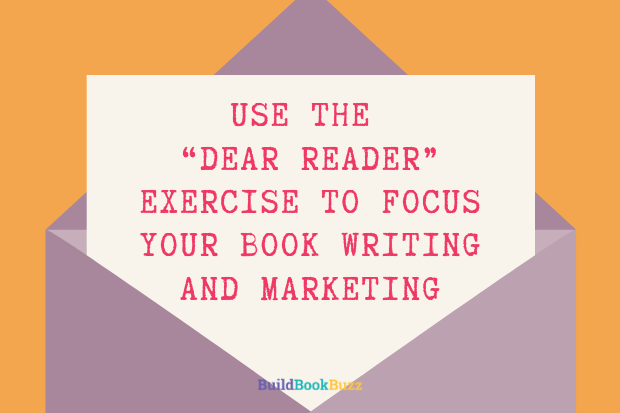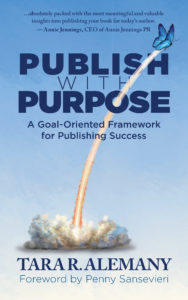Use the “Dear Reader” exercise to focus your book writing and marketing
The "Dear Reader" exercise will give you focus and clarity before you write and market your book. Tara Alemany tells us how to do it.
Affiliate Disclosure: This post contains Amazon Associates links, which means if you click on them and make a purchase, I will receive a couple of pennies (at no extra charge to you).

Book publisher Tara Alemany and I have crossed paths many times because our professional networks overlap, but we never talked directly until she asked me to blurb her new book, Publish With Purpose: A Goal-Oriented Framework for Publishing Success. (Spoiler alert: I loved it!) I thought the “Dear Reader” exercise she described in the book was so important and helpful that I asked her to write a guest post about it. Fortunately for us, she agreed.
Tara Alemany is a multi-award winning author, speaker, business consultant, and publisher, as well as a serial entrepreneur. Although she’s started many businesses during her career, her favorite by far is Emerald Lake Books, which she co-owns with her best friend, Mark Gerber. This hybrid publishing company provides a unique blend of business coaching with publishing to help its authors succeed. Emerald Lake Books specializes in working with positive people who have an engaging, exciting or entertaining message to share.
Use the “Dear Reader” exercise to focus your book writing and marketing
By Tara Alemany
In October 2017, I heard Justin Spizman give a talk where he shared his “Dear Reader” exercise. A ghostwriter and book architect, Justin uses this exercise to help his clients clarify who their book is for early in the writing process.
When you have a clear picture of who your ideal reader is, it allows you to write specifically for them. But it also allows you to feel more connected to them and to write in a more conversational way. Because it’s less formal, it makes for a much more engaging book.
As a publisher, I have since adapted and expanded his exercise for our own clients.
The “Dear Reader” exercise
Here’s how you can do the Dear Reader exercise yourself. The idea is, you’re going to write a letter to your prospective new reader.
If your book is nonfiction, you want to provide answers to the following questions in your letter:
- Who are you?
- What is this book about?
- What inspired you to write it?
- Who will it help?
- Why are you the expert on this topic?
- What makes your book unique?
- What promise are you going to make the reader?
If your book is fiction, the questions are slightly different.
- Who are you?
- What is this book about?
- What inspired you to write it?
- Why do you love this story?
- What do you hope the reader will enjoy most about it?
- What promise are you going to make the reader?
Whether you’re a fiction or nonfiction author, write the letter as if you’re speaking directly to that reader, using the first and second person (“you” and “I”).
The completed letter should only be two to three pages long, but it will help you gain clarity regarding the outcome you want for your reader.
Keep in mind, this is not a questionnaire. This is a letter you’re writing to a prospective reader. In it, you want to create a connection that demonstrates you know who they are and what their needs are, as well as why your book is the answer to what they’re seeking, whether it’s entertainment, encouragement, or enlightenment.
Test drive the letter
If you have a coach or someone you trust who can provide honest feedback, share the letter with them. You want to hone and refine the letter until you’re really clear about who the book is for and why this particular book will benefit them.
Your promise to the reader, should they invest their time and money in you, has to resonate as something that particular reader will truly want. Getting feedback from a trusted source for this refining process is crucial. If you find you want more help with this exercise, we are happy to guide you through the process and provide feedback. Simply book a time with us at elbks.com/reader-ex.
When the letter is ready, share it with your editor. This allows them to verify that you have delivered on your promise to the reader as they edit your manuscript, and ensures the book is as strong as it can be. At the editing stage, you can still make changes, if necessary, to help the book achieve your intended purpose.
Reaping the benefits
Here are some of the benefits that come from doing this exercise:
- You’ll have a clear picture of who your ideal reader is, what their needs are, and how you can serve them, which will help both your writing and your marketing efforts.
- You’ll have a better idea of what’s “in scope” for this book, and what material you should save for later use.
- It will give your editor a better understanding of what you hope to convey to your reader.
- Portions of your Dear Reader letter may work well as marketing material, cover copy, your book listing description, or an introduction to your book.
Simple, but not easy
I have to admit, writing my own Dear Reader letter for my book, Publish with Purpose, was an emotional experience. Writing the letter forced me to reconnect with why I was writing the book and who I was writing it for, instead of what it was that I wanted to write.
“What” is a very intellectual question. But “who” and “why” are all about the connections I was trying to make and the purpose I was trying to serve. And the answers to those questions reside more in my heart than my mind.
So when you do this exercise, be sure to give yourself some space and time to truly process it. I promise, it’s worth it and your readers will thank you!
Have you tried this exercise before? Did it help give you clarity?
Like what you’re reading? Get it delivered to your inbox every week by subscribing to the free Build Book Buzz newsletter. You’ll also get my free “Top 5 Free Book Promotion Resources” cheat sheet immediately!



I love this! Thank you!
Thanks, Jeannine! I love it, too!
Sandy
I’m glad you found it useful! Everyone we’ve talked to who have used it found it to be extremely helpful. The results speak for themselves, though. Thus far this year, our authors who have truly taken this exercise to heart (along with the others outlined in “Publish with Purpose”) have garnered 8 awards. Their books are really connecting with readers!
great
This is an excellent idea. I’m working through the third draft of my new book, but I’m going to stop and do this exercise. I can see where it will help tighten the overall book. Thank you!
I love it, too, Linda. It’s going to be part of my process going forward. It’s just one part of Tara’s excellent book that’s designed to help give us focus before we go too far with our writing.
Sandy
That’s great to hear, Linda! I’d love to hear your thoughts after you’ve tried it.